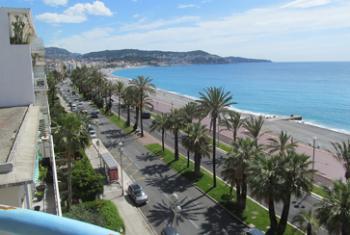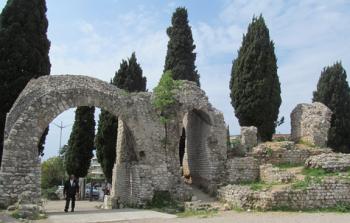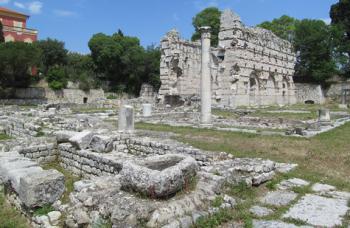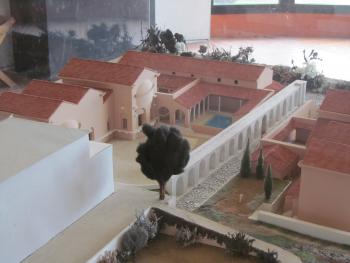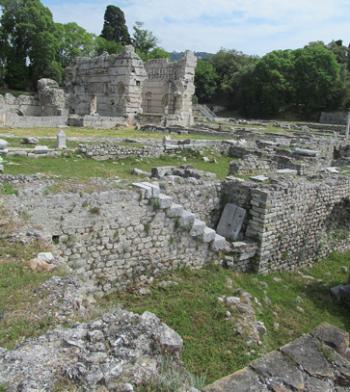Cemenelum - Roman city on the French Riviera
This item appears on page 50 of the January 2019 issue.
The last thing I expected to find in the French Riviera city of Nice was the ruins of a 2,000-year-old Roman city. The Mediterranean, miles of beaches, the famous Promenade des Anglais adjacent to those beaches, yes. Several fabulous art museums, certainly. Cafés, bistros, restaurants, of course. But a Roman city just a few miles from Nice's alluring beachfront was a surprise.
Located in the upscale residential area of Cimiez in Nice, with villas set in lush gardens, what was once the Roman city of Cemenelum lies almost overwhelmed by the surrounding neighborhood.
In fact, only about 12%, or about 6 acres, of Cemenelum has been excavated. The other estimated 88% still lies beneath Cimiez, a 15-minute cab ride from the Promenade des Anglais and the beaches.
Cemenelum was founded in 14 BC as a military and administrative center on the strategic Roman road Via Julia Augusta. It quickly rose to provincial capital of the Alpes Maritimae province, a title it eventually lost at the end of the 3rd century AD to another Gallic city.
Cemenelum briefly regained importance in the 5th century as the site of a Christian bishopric. This, too, was lost in the following century, and so began Cemenelum's final decline as its close neighbor, Nice, rose to prominence. Cemenelum/Cimiez was eventually incorporated into Nice.
Roman amphitheater
The first Roman-era structure visitors see upon arrival at the Cemenelum site is the amphitheater. Once capable of seating at least 5,000 spectators, who came for gladiatorial combats, it's now sometimes used as a parking lot — sad, but you can still see the amphitheater's original entrance tunnels and some intact rows of seats.
A few feet away from the amphitheater is the Musée d'Archéologie de Nice (160 avenue des Arènes de Cimiez; phone 33 [0] 4 93 81 59 57), which is open the same hours as Cemenelum. Visitors must enter through the museum to reach the Cemenelum archaeological site. It's best to save a visit to the museum until after you've seen the site.
Roman baths
The archaeological site consists mainly of three Roman bathing complexes that stand companionably close to each other.
If one follows the recommended route through the site — a good idea — one comes first to the Northern Baths, the oldest of the three bathing complexes. Dating from the 1st century AD, these baths included a palaestra, or gymnasium for exercise, the frigidarium (cold water), tepidarium (warm water) and caldarium (hot water). Adjacent to the tepidarium was the laconicum for dry heat.
Bathers would progress from cold to warm to hot baths (although this was not always the order followed in other Roman bathhouses), probably socializing along the way, since Roman baths were places for meeting friends as well as for cleansing.
A large section of the Northern Bath's frigidarium still stands. A farmhouse was built inside it in the 1600s, helping save it from further devastation and deterioration.
A few steps away lies the Eastern Baths, built toward the end of the 1st century BC. Here you can see an example of a hypocaust that heated floors as well as the water for the warm and hot baths.
Short terra-cotta pillars supported a floor. Hot air from a nearby praefurnium, or furnace, circulated among the pillars to heat the floors and pool water. A section of a residential area of Cemenelum lies just beyond the Eastern Baths.
The most recent of the three baths is the Western Baths, built in the 3rd century AD. It is especially interesting because in the 5th century AD, when these baths were no longer used, a church was built inside the baths.
The apse of the church was in the frigidarium, the nave occupied the tepidarium and the two caldaria, and a baptistry was in the praefurnium. Not much remains of this early Christian church.
The on-site museum displays finds excavated from here and nearby — statues, sarcophagi, stelae. There are models of the three baths that make it easy to visualize what they once must have looked like.
Matisse Museum
Not to be missed is the museum that is located next door to the archaeology museum. It's not archaeological, although it sits on top of ancient Roman Cemenelum. It's the Musée Matisse (164 avenue des Arènes de Cimiez; phone +33 [0] 4 93 81 08 08, www.musee-matisse-nice.org), exhibiting a selection of Henri Matisse's art from all periods of his life.
Much more in Nice
Besides Cemenelum and the Muséé Matisse, Nice is full of things to see and do. Just a few recommendations — strolling along the Promenade des Anglais beside the sea; exploring the dark, narrow streets of Vieux Nice (Old Nice); visiting the Musée National Marc Chagall and the Musée International d'Art Naïf Anatole Jakovsky; browsing and buying flowers at the vibrant Cours Saleya market; taking day trips to Monaco, Cannes, Antibes, Saint-Paul de Vence and a host of other towns relatively close to Nice. And, oh, those cafés and bistros…
If you go…
Cemenelum and its on-site museum are open 10 to 6, Wednesday to Monday, from late June to mid-October and 11 to 6 from mid-October to late June; it's closed on some holidays. The entry fee is €10 (near $11.50). It's wise to call to check on these hours before visiting.
My husband, Paul, and I rented an apartment for our nine nights in Nice in May 2018. It was difficult to choose one from the colorful catalog of the Pebbles company, since each had something special about it. We finally decided on one called Promenade (Pebbles, 37 rue de l'Hôtel des Postes, Nice; phone 33 [0] 4 97 20 27 30, www.nicepebbles.com) because of its panoramic views of the Mediterranean from its private, 6th-floor, wraparound terrace.
The apartment was spacious, with a combined living/dining room, two bedrooms, two bathrooms and a well-equipped kitchen with both washing machine and dishwasher.
The cost for the nine nights at $290 per night was $2,610. To find the apartment listing on the website, under the heading "OUR SERVICES," click on "2 bed" and scroll to "Promenade."

